|
Lhasa
Lhasa, a city of wonders, is the capital of the Tibet Autonomous Region. The Tibet Autonomous Region is known worldwide as the Roof of the world for its average elevation of 4,000 meters above sea level. Tibet is charming, with its beautiful landscape, brilliant culture, and mysterious folklore. "Lhasa" means "sacred place" in local dialect. It has abundant sunshine, hence its reputation as the Solar City. It is a center of politics, economy, transport, and religious activities. There are many places of interest in Lhasa, such as the Potala Palace, and the Jokhang Monastery.
Recommended Lhasa Tours:
Recommended China Tours Including Lhasa:


|
Tourist Highlights
|
| |
Potala Palace
Lhasa's cardinal landmark - Potala Palace, a structure of massive portions. Its towering image already appearing on various occasions, but your first sight of the Potala will still be an awe-inspiring moment. In 641, upon marrying Princess Wencheng, Songtsen Gampo decided to build a grand palace to accommodate her and to serve as a memorial to this important event. However, the original palace was destroyed by lightening and war damage during Landama's reign. In seventeenth century under the reign of the Fifth Dalai Lama, Potala was rebuilt. The Thirteenth Dalai Lama extended it to its present size. The monastery like palace, reclining against and capping Red Hill, was the religious and political center of old Tibet and the winter residence of Dalai Lamas. It is more than 117 meters (384 feet) in height and 360 (1180 feet) in width, occupying a space of 90 thousand square meters.
|
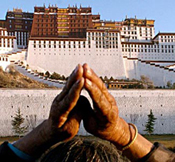 |
|
 |
Jokhang Temple
Jokhang Temple, built in 647A.D and located in the centre of old town Lhasa, it is one of the earliest constructions in Tibet, its roof is covered gold, making much of a sight. Through several renovations it expanded into quite a large group of buildings and now covers an area of over 25,000 sq meters. A large number of precious. Walls along lobbies and inner temples are covered with legendary frescoes. Jokhang Temple is the most revered religious structure in Tibet. |
|
Bargor Street
Bargor Street, a flourishing street around jokhang Temple, is the oldest street in a very traditional city in Tibet. Along the street are stores and groceries selling light industry products and handicrafts made by locals or Nepal makers. Today, 50,000 tourists and businessmen pour into this thoroughfare every day. It is also the main route for prayer wheels rotaing.
|
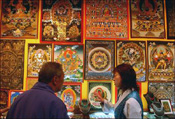 |
|
 |
Drepung Monastery
Drepung Monastery, the largest and richest monastery in Tibet, was founded in 1416 by a disciple of Tsong Khapa under the patronage of a noble family and later enlarged by the Fifth Dalai Lama. Drepung, which means rice heap in Tibetan, lies 8 kilometers west of Mt. Gambo Utse. The monastery covers a floor space of more than 200 thousand square meters. At its peak, it had a registration of more than 10,000 monks. Walking up to the hill is a pleasant thing, an easy break from the solemn ambience inside the halls and chapels. At the plat roof of hillside, you can have very good views of the whole Lhasa city and the distant mountains. |
|
Sera Temple
Drepung is one of Lhasa's two great Gelugpa monasteries, the other is Sera. Sera may not be as grandiose as Drepung, but is more serene surrounded by many small temples. The "Buddhism Scriptures Debating" in Sera is very famous. In 1414, Jamchen Chojey (or Sakya Yeshe), one of Tsong Khapa's disciples, visited Emperor Chengzu as Tsong Khapa's emissary. The Emperor Chengzu granted him a title of Dharma King of Great Mercy, sutras, and a set of sandalwood Arhats. In order to preserve them, Tsong Khapa instructed Jamchen Chojey to build a monastery to house the treasures. The Sera monastery was completed in 1419.
|
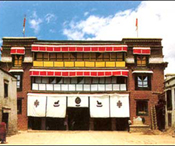 |
|
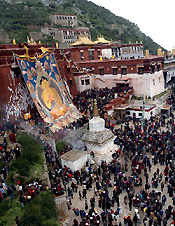 |
Gandan Temple
Built in the 15th century by the presinding of Chongkhapa .The monastery lies 45 kilometers (28 miles) east of Lhasa. Lying on the mountainside, it looks magnificent and grand. Ganden Monastery is one of the earliest and largest Buddhist monasteries in Tibet, and stands atop of the six famous temples of Gelugpa - a branch of Tibetan Buddhism. Its significance as a religious, artistic, political and cultural relic led to it being preserved by the National Key Cultural Relic Preservation scheme in 1961, and is now known as being one of the 'Three Great Temples', together with the Sera Monastery and the Drepung Monastery. Every year, one of the grandest of Buddhist activities - Buddha Painting Unfolding Festival - is conducted in the monastery, attracting thousands of visitors and disciples. |
|
Norbulingka Park
Norbulingka, meaning "Treasure Park", Located at the west suburb of Lhasa. It was constructed during 1740s, and is 36hectres in area. The standing minister of Tibet by Qing Govermnent ordered the first palace to be built for the recreation of the 7th Dalai Lama; later, the 8th, 13th, 14th, Dalai Lamas also built their own palaces here. After 200 years extension and management, it has become one of typical Tibetan Palaces and gardens. Dalai Lamas, from the 7th down, all spent summers here, while doing business. Before 1959, common people had no access to the palace. |
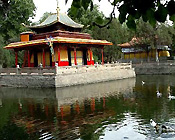 |
|
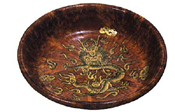 |
Tibet Museum
The Tibet Museum is located in the southeast corner of Norbu Lingka, Lhasa city. It covers an area of 23,508 square meters (5.8 acres) including the exhibition area of 10,451 square meters (2.6 acres). The museum is equipped with modern facilities to ensure quality service for visitors and safety and efficient administration of the museum itself. Here exhibits are introduced in Japanese, English, Tibetan, and Chinese, in order to accommodate visitors from all over the world. |
| |
Recommended Lhasa Tours:
Recommended China Tours Including Lhasa:


|
|
| Other City |
|
|
 |
| Private China Tours |
|
|
 |
|

